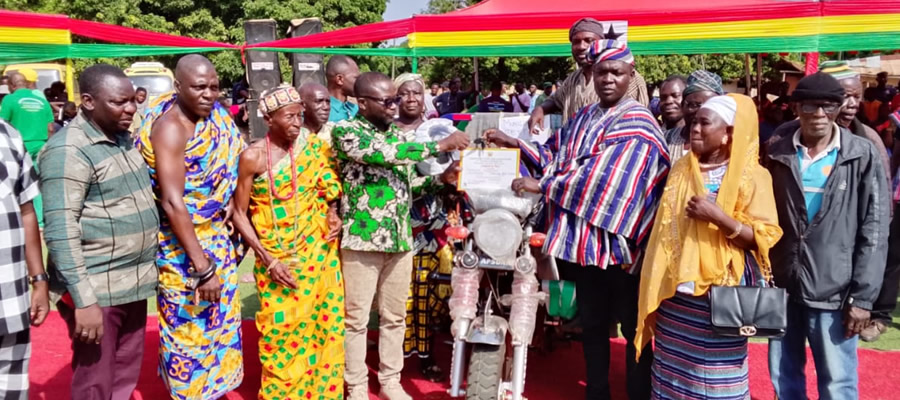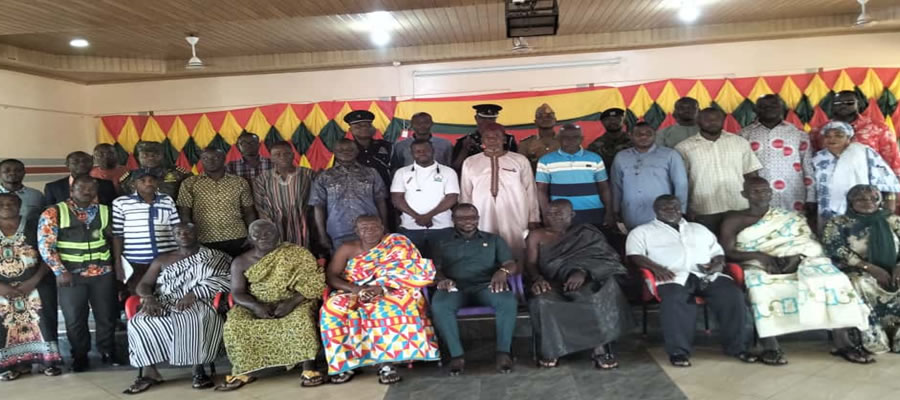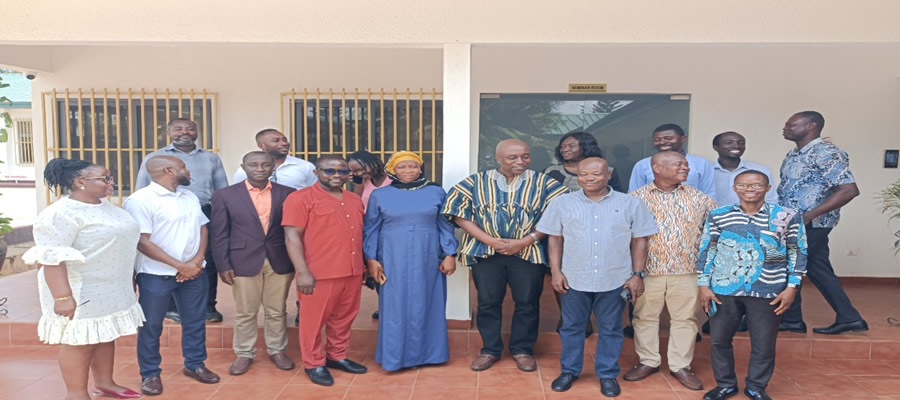

The Municipal Assembly is the highest political and administrative authority with the Municipal Chief Executive as both the administrative and political head .The Co-ordinating Director is responsible for the day to day Administration of the Assembly. The municipality has four zonal councils, which are located in Kintampo, Babatokuma, Kadelso, and New Longoro. These councils assist the planning authority in the implementation of government policies and programmes.
The Municipal Chief Executive heads the office of the Municipal Assembly. The Municipal Assembly comprises the Municipal Chief Executive, forty-five (45) elected members, ninetenn(19) appointed members and one (1) Member of Parliament who has no voting rights. Administratively the Municipality is divided into four(4) thus Kintampo Town, Babator, New longoro and Kadelso zonal councils and five(5) Unit Committee members each in thus two hundred and twenty-five(225) unit committees. Politically the Municipality has one constituency namely the Kintampo North and forty-five (45) electoral areas.
Municipal Assembly Expenditure
The Central Administration of the Kintampo North Municipal Assembly does not thrive on any source of income in funding its recurrent expenditure, as do other decentralized departments of the Assembly. It wholly finances this expenditure through its locally generated revenues. The current decentralization Programme places the Central Administration within the framework of a co-ordinating body of the activities of the other decentralized departments. The items of expenditure of the District Assembly range from personal Emoluments, Traveling and Transport, General Expenditures, Maintenance, Repairs and Renewals especially of buildings and miscellaneous expenditures. Aside these, the Municipal Assembly is expected to undertake some form of capital expenditures which involve all forms of expenditures under any specific capital project, aimed at supplementing those under provision under the DACF.
Development is not only multi-faceted but inter-disciplinary thus entailing the involvement of several specialists in the development decision making process. The people must operate within clearly defined administrative or institutional structures indicating the various levels of interaction between them. It is only when there is a clearly defined chain of communication and role playing, that problem identification, choosing between alternative courses of action, mobilizing, allocating and utilizing resources to solve societal problems could be easily carried out. Therefore, undoubtedly an efficient institutional structure is a pre-requisite for ensuring effective allocation of resources for development.
This sub-section therefore touches on the composition and structure of the Kintampo North Municipal Assembly and other related institutions. The roles of these institutions and agencies in planning and implementation and hence, in the overall development of the Municipal among other things, are also examined.
Composition of the Municipal assembly
In line with the Local Government Act 1993 (Act 462), the Kintampo North Municipal Assembly is the highest political and administrative authority in the Kintampo North Municipal.
As provided by section 5 of the Act, the Assembly consists of the following members.
- The Municipal Chief Executive
- One Assembly member elected from each of the 25 electoral areas.
- The member(s) of parliament from the constituencies that fall within the area of authority of the Assembly
- Presidential appoints whose number does not exceed 30% of the total membership of the Assembly. There is also a presiding member elected from among the Assembly members.
Currently the Assembly has 25 elected Assembly Members with 11 government appointees with a Member of Parliament from Kintampo North Constituency as well as the Municipal Chief Executive of the Assembly making a total of 38 members. Out of this number, only one (1) woman was elected into the Assembly in the 2006 district level elections with two (2) women appointed in addition making a total of three (3) women representing 7.89% of the total membership. Table 1.11 contain the composition of the Municipal Assembly membership.
In addition, there is an Executive Committee of 12 members which according to the Act, is chaired by the Municipal Chief Executive and is responsible for the performance of the executive and administrative functions of the Municipal Assembly; sub-committees, a Municipal Planning Co-ordinating Unit (MPCU), an administrative unit, Decentralised Departments, other government agencies and the community.
The Executive Committee
The Executive Committee is chaired by the Municipal Chief Executive and consists of not more than 2/3 majority of membership of the Assembly. It has the following sub-committees:
- Development Planning
- Social Services
- Public Relations
- Works
- Justice and Security
- Finance and Administration
- Agric
- Environment and Sanitation
- Disaster
Section 21 of Act 462 provides that the Executive Committee shall, among other functions;
- Co-ordinate plans and programmes of the sub-committees and submit these as comprehensive plans of action to the Municipal Assembly.
- Develop and execute approved plans of the unit, area and town and sub-metropolitan districts as the case may be within the area of authority of the Municipal Assembly.
The Sub Structures
The whole concept of decentralization is grounded on the idea of popular participation in the decision–making process .Therefore; the main policy objective of setting up the sub- structures is to try to actualize this concept as comprehensively as possible. The structure is sub-divided in to four administrative sub-structures (urban and area councils). These are the Kintampo Urban council, Babatorkuma Area council, Kadelso Area council and New Longoro Area council. Unit committees are yet to be established.
The fact still remains that the sub-Municipal Institutions have a long way to go since they are not properly functioning due to the non-existence of permanent staff at the Sub- level. The capacity of the councillors and unit committee members is also inadequate to perform their statutory functions effectively. In terms of office accommodation, only Kintampo Urban Council has office accommodation which is still under construction. However, the facility will not be fully utilised if permanent staff and other logistics are not provided.
The Departments
Section 38 and the first schedule of Act 462 enjoin a Municipal to establish the following eleven (11) departments:
I. Central Administration Department
II. Finance Department
III. Education, Youth & Sports Department
IV. Municipal Health Department
V. Agriculture Department
VI. Physical Planning Department
VII. Social Welfare and Community Dev’t Department
VIII Natural Resources Conservation Department, Forestry Game and Wildlife Divission
IX. Works Department
X. Industry and Trade Department
XI. Disaster Prevention Department
These eleven (11) departments replace the former twenty two (22) decentralised departments listed under the schedule eight of the Act. The Municipality has the full compliment of these departments. Despite the existence of almost all the decentralised Departments, there is the need for the sector Departments to re-define their roles and functions and their relationships in the integration process. Also, the sector Departments are not fully integrated into the Municipal Assembly system. Most of the Departments still continue to look up to their mother departments and ministries for policy direction and Implementation.
Problems Facing the Decentralised Departments
A summary of the problems facing decentralised departments are as follows:
- Inadequate staff accommodation
- Inadequate office accommodation
- Inadequate skilled personnel
- Inadequate logistics e.g. Vehicle, computers etc.
Relationship of Municipal Assembly with Other Institutions and Organizations There are a number of other institutions and organizations in the district which work in collaboration with the Assembly towards the development of the district. These include public institutions, traditional authorities, multilateral and non-governmental and private business organizations.
Some of the public institutions include the Volta River Authority (VRA), Ghana Highways Authority (GHA), and National Commission on Civic Education (NCCE), Ghana Telecom and others. The traditional authorities (Chiefs) also play an important role in the development in the district. They are very instrumental in mobilizing resources for community development. However, the prevalence of chieftaincy disputes in the district down plays this vital role of the chiefs.
Multi-lateral and non-governmental organizations operating in the district include the British American Tobacco Company Limited, the Kfw, GTZ/LG-PRSP, GTZ/RUTIPP, CWSA, ADRA, IFAD, and CBRDP among others. These organizations operate in partnership with the Assembly and undertake several development Programmes and Projects. The contributions of these institutions and organizations towards the district’s development are enormous. Therefore, the Assembly should encourage and create an enabling environment for their smooth operation. Their activities should also be, where possible and necessary, coordinated by the Assembly to ensure efficiency in resource allocation for the district’s development.
Date Created : 11/16/2017 7:29:03 AM












 facebook
facebook
 twitter
twitter
 Youtube
Youtube
 +233 593 831 280
+233 593 831 280 0800 430 430
0800 430 430 GPS: GE-231-4383
GPS: GE-231-4383 info@ghanadistricts.com
info@ghanadistricts.com Box GP1044, Accra, Ghana
Box GP1044, Accra, Ghana